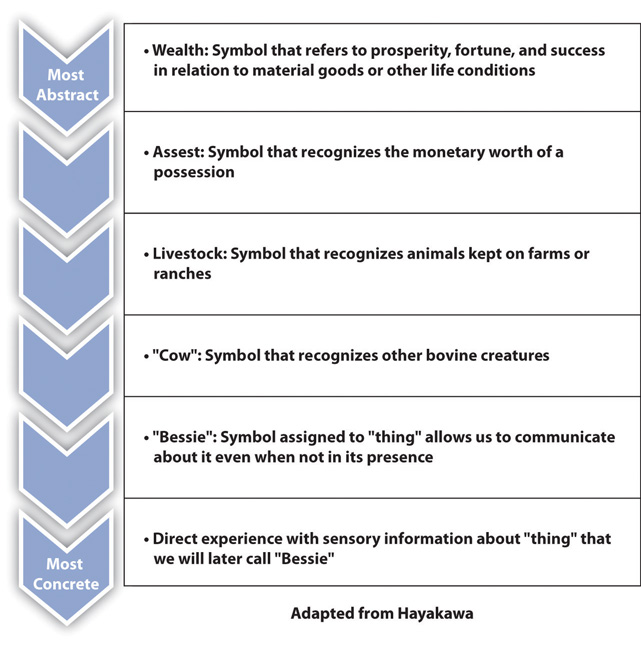Chapter 2 Verbal Communication
2.4 Semantic Misunderstandings & Skills for Using Language Well
While our language can help us create shared meaning (i.e., communicate) with others, there are things that can get in the way of this process. Have you ever gotten lost because of how someone gave you directions? Or had someone paraphrase what they heard you just say, only to think “that’s not what I said at all!” Lets take a look at why that might have happened.
I. Semantic misunderstandings
Semantic misunderstandings occur when people assign different meanings to a word or utterance. There are four common types of semantic misunderstandings: bypassing, abstraction, relative language, and equivocatios.
Bypassing[1]
Bypassing occurs when individuals think that they understand each other but actually they miss each other’s meaning. There are two types of bypassing that are the most common, the first is when two people use different words or phrases to represent the same thing.
 |
TOILET | JOHN | HEAD |
The second is when people give different meanings to the same word or phrase (Gamble and Gamble, 2013, pg85).  Bypassing can cause many miscommunication problems that at times might be completely unnecessary. For example, when people say or use the word gay. One person might think its related to the sexuality of someone. There are others that say “that’s gay” to them, it might mean that’s sucks, or others might use the word gay as happy. That’s a word that can get people into problems and or arguments, there are many words like that in the English language, gay being one of many.
Bypassing can cause many miscommunication problems that at times might be completely unnecessary. For example, when people say or use the word gay. One person might think its related to the sexuality of someone. There are others that say “that’s gay” to them, it might mean that’s sucks, or others might use the word gay as happy. That’s a word that can get people into problems and or arguments, there are many words like that in the English language, gay being one of many.
Abstraction [2]
The ladder of abstraction is a model used to illustrate how language can range from concrete to abstract. As we follow a concept up the ladder of abstraction, more and more of the “essence” of the original object is lost or left out, which leaves more room for interpretation, which can lead to misunderstanding. This process of abstracting, of leaving things out, allows us to communicate more effectively because it serves as a shorthand that keeps us from having a completely unmanageable language filled with millions of words—each referring to one specific thing.[1] But it requires us to use context and often other words to generate shared meaning. Some words are more directly related to a concept or idea than others. If I asked you to go take a picture of a book, you could do that. If I asked you to go and take a picture of “work,” you couldn’t because work is an abstract word that was developed to refer to any number of possibilities from the act of writing a book, to repairing an air conditioner, to fertilizing an organic garden. You could take a picture of any of those things, but you can’t take a picture of “work.”

You can see the semanticist S. I. Hayakawa’s classic example of the abstraction ladder with “Bessie the cow” in Figure 3.2 “Ladder of Abstraction”.[3] At the lowest level, we have something that is very concrete. At this level we are actually in the moment of experiencing the stimuli that is coming in through our senses. We perceive the actual “thing,” which is the “cow” in front of us (either in person or as an image). This is concrete, because it is unmediated, meaning it is actually the moment of experience. As we move up a level, we give the experience a name—we are looking at “Bessie.” So now, instead of the direct experience with the “thing” in front of us, we have given the thing a name, which takes us one step away from the direct experience to the use of a more abstract symbol. Now we can talk and think about Bessie even when we aren’t directly experiencing her. At the next level, the word cow now lumps Bessie in with other bovine creatures that share similar characteristics. As we go on up the ladder, cow becomes livestock, livestock becomes an asset, and then an asset becomes wealth. Note that it becomes increasingly difficult to define the meaning of the symbol as we go up the ladder and how with each step we lose more of the characteristics of the original concrete experience.
When shared referents are important, we should try to use language that is lower on the ladder of abstraction. Being intentionally concrete is useful when giving directions, for example, and can help prevent misunderstanding. We sometimes intentionally use abstract language. Since abstract language is often unclear or vague, we can use it as a means of testing out a potential topic (like asking a favor), offering negative feedback indirectly (to avoid hurting someone’s feelings or to hint), or avoiding the specifics of a topic.
Relative Language
Relative language is language that takes on meaning by comparison. Semantic misunderstandings occur when people give meanings to words based on their personal experiences (i.e., its relative). What does it mean to be “on time”, or what is “cheap”? For some, on time means arriving 5 minutes before the start of an event, whereas for others on time can be arriving 30 minutes after the event begins. What “cheap” means to someone like Bill Gates is probably different then “cheap’ to us. Our personal experiences and environments can affect the meaning we give to words.
Equivocation
Equivocations are utterances with two or more plausible interpretations. This can be problematic when we are trying to create shared meaning with others. Here are some funny “ripped from the headlines” examples of equivocal statements. While we probably know what is meant, we can chuckle at the potential other interpretation(s).
Disruptive language
Disruptive language evokes psychological noise in the listener (think back to the transnational model of communication), which limits their ability to stay present in the conversation and take in all of what is said.
Fact-Inference-Opinion
When in communication with others, it can be confusing when people report inferences as or opinions as fact. If you’ve ever thought to yourself “Did that really happen, or is that just what the person thinks/feels”?, you have experienced this disruptive language behavior. Factual statements are utterances that can be verified as true or false. Inferences are conclusions drawn from a fact, and opinion statements express how the speaker thinks or feels.
Fact: Sally has her hair in a ponytail
Inference: Sally was running late today, so she had to put her hair in a ponytail [in reality, we dont know that she was running late just because her hair is in a ponytail]
Opinion: Sally looks good with her hair in a ponytail. [our evaluation of her appearance but not everyone’s]
Fact: An adult woman and child who looks like an elementary school aged kid are walking together, the adult woman carrying a backpack
Inference: The mom is carrying the child’s backpack [we dont know the relationship between these two individuals, and dont know that the backpack is actually the childs]
Opinion: The mom is a caring parent [our evaluation, but not everyone’s]
Emotive language
Vivid language captures people’s attention and their imagination by conveying emotions and action. Think of the array of mental images that a poem or a well-told story from a friend can conjure up. Evocative language can also lead us to have physical reactions. Words like shiver and heartbroken can lead people to remember previous physical sensations related to the word. As a speaker, there may be times when evoking a positive or negative reaction could be beneficial. Evoking a sense of calm could help you talk a friend through troubling health news. Evoking a sense of agitation and anger could help you motivate an audience to action. When we are conversing with a friend or speaking to an audience, we are primarily engaging others’ visual and auditory senses. Emotive language can help your conversational partner or audience members feel, smell, or taste something as well as hear it and see it. Good writers know how to use words effectively and affectively. A well-written story, whether it is a book or screenplay, will contain all the previous elements. The rich fantasy worlds conceived in Star Trek, The Lord of the Rings, Twilight, and Harry Potter show the power of figurative and evocative language to capture our attention and our imagination. Some words are so emotive, however, that affect the other’s ability to keep listening. Read the following and consider how your reactions may change as the words used change:
The girl is an Executive of IBM. The woman is an Executive at IBM. The broad is an executive at IBM.
The loved one will be buried. The deceased will be buried. The corpse will be buried.
Frank is arrogant. Frank is outspoken. Frank is confident.
II. Skills for Using Language Well
When people don’t use words well, there are consequences that range from mild annoyance to legal actions. When people use words well, however, they can be inspiring and make us better people. In this section, we will look how we mitigate the problematic language issues discussed above.
- Engaged in person-centered communication. Remember that words are symbols, there is no inherent meaning in a word. Effective communicators adapt their language to the individuals with whom they interact, recognizing that people’s past experiences, expectations, and goals affect affect how they interpret words. If a misunderstanding occurs, it isnt one person’s faulty…we are creating meaning with each other.
- Be aware of disruptive language. When sharing a difficult message, thoughtfully consider your word choice. You want the others to stay present in the conversation, so try to limit emotive language. If we are listening to an emotive message, we should try to “listen past” the word choice so we hear their entire message.
- Ask for clarification. If someone says “That’s an easy class”, remember the relative nature of the word “easy” and ask them what “easy” is to them. If someone says “That’s annoying” we should remember the abstract nature of that utterance and ask them which behaviors, specifically, they find annoying. Alternatively, it is helpful to ask others to paraphrase back to us what they “heard” us say, to see if they interpreted your words the way you meant them.
Media Attributions
- TOILET

